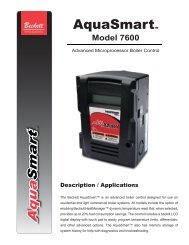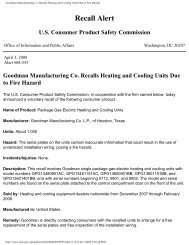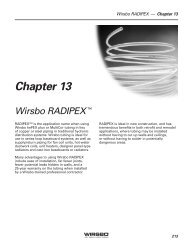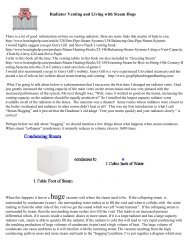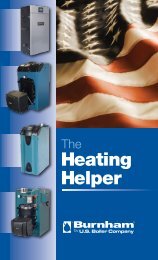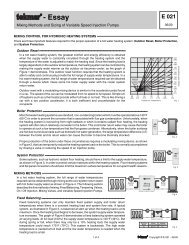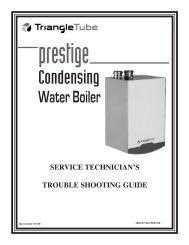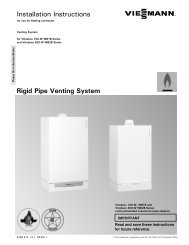Burnham V8 Series Instructions.pdf - Heating Help
Burnham V8 Series Instructions.pdf - Heating Help
Burnham V8 Series Instructions.pdf - Heating Help
You also want an ePaper? Increase the reach of your titles
YUMPU automatically turns print PDFs into web optimized ePapers that Google loves.
SECTION VII: VENTING AND AIR INTAKE PIPINGA. GENERAL VENTING GUIDELINES1. Vent system installation must be in accordance withthese instructions and applicable provisions of localbuilding codes. Contact local building or fireofficials about restrictions and installation inspectionin your area.2. The <strong>V8</strong> is designed to be vented into a fireclay tilelinedmasonry chimney or chimney constructed fromtype L vent or a factory built chimney that complieswith the type HT requirements of UL103. Thechimney and vent pipe shall have a sufficient draft atall times, to assure safe proper operation of theboiler. See Figure 16 for recommended installation.a. Install a draft regulator (supplied with boiler)following the instructions furnished with theregulator. See Figure 17 for alternate draftregulator locations.b. For the <strong>V8</strong>2W, <strong>V8</strong>4W and <strong>V8</strong>6W the minimumrecommended chimney size from Table 1B is onesize larger than the smokebox outlet. For avertical vent, place the increaser on thesmokebox outlet collar. Otherwise, locate theincreaser in the horizontal vent at the entrance tothe chimney.c. With any new or replacement installation thechimney has to be considered. Chimneys thathave a high heat loss may become less suitable asthe heat loss of the home goes down and theefficiency of the boiler installed goes up. Mosthomes have a chimney appropriate for the fueland the era in which the home was built. Thatmay have been a coal fired or an inefficient oilfired boiler built into a home without insulationor storm windows. With increasing fuel pricesthat home probably has been insulated and fittedwith storm windows so that the heat loss of thehome has been reduced. This requires less fuel tobe burned and sends less heat up the chimney.A new boiler probably has a higher efficiencythan the boiler being replaced. That probablymeans that the stack temperature from the newboiler will be lower than that from the old boilerand with less room air being drawn up thechimney to dilute the stack gases. Thecombination of a large uninsulated chimney,reduced firing rate, reduced firing time, lowerstack temperature and less dilution air can, insome cases, contribute to the condensing of smallamounts of water vapor in the chimney. Suchcondensation, when it occurs, can cause chimneydeterioration. In extreme cases, the chimney mayhave to be lined to insulate the chimney and thusprevent the condensation. The addition ofdilution air into the chimney may assist in dryingthe chimney interior surfaces.A massive chimney on a cold, or exposed outsidewall may have produced adequate draft when itwas fired with a higher input and greater volumesof heated gases. With reduced input and volume,the draft may be severely affected. In oneinstance our research showed a new chimney ofadequate sizing produced only -.035" W.C. after30 minutes of continuous firing at 13.0% CO 2.Outside wall chimneys take longer to heat up andcan have .00" W.C. draft at burner start-up. Youmay have to consider a special alloy chimneyflue liner with insulation around it and astabilizing draft cap or even a draft inducing fanin severe cases.d. For the same reasons as in c. above, heatextractors mounted into the breeching are notrecommended.3. For minimum clearances to combustible materialsrefer to Figure 2.B. OPTIONAL AIR INTAKE PIPINGINSTALLATION - All air for combustion can besupplied directly to the burner from outdoors (ONLYAVAILABLE WITH BECKETT BURNER). SeeFigure 18.WARNINGDo not reduce size of air intake pipe.Read, understand and follow combustionair instruction restrictions contained in thePre-Installation Section of this manual.1. Generala. Use 4 inch diameter, single wall galvanized metalpipe and fittings available at most heatingdistributors for air intake piping. Maximumallowable air intake length is 50 equivalent feet.Each elbow is equal to 6 equivalent feet.WARNINGDo not exceed maximum allowable airintake length.b. Start at Burner. Work toward air intake terminal.c. Maintain minimum of ¼ inch per foot slope inhorizontal run to air intake terminal. Slope downtoward air intake terminal.d. Seal all joints gas-tight, using silicone caulk orself-adhesive aluminum tape.34



